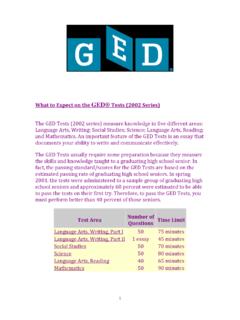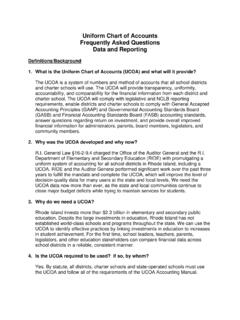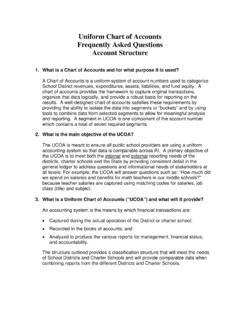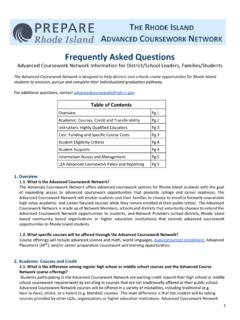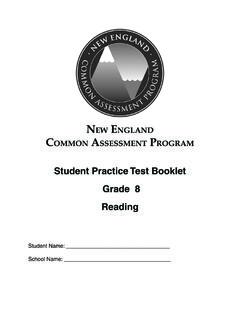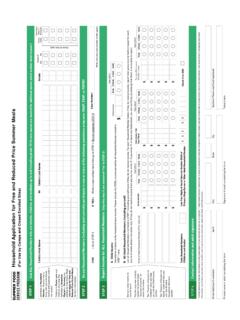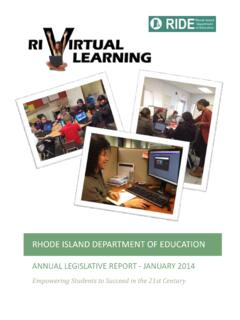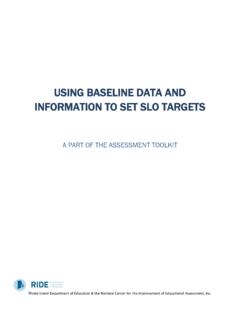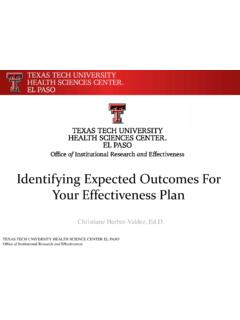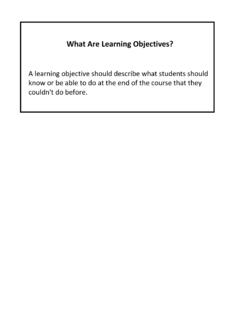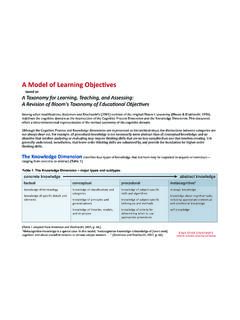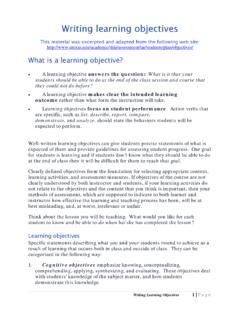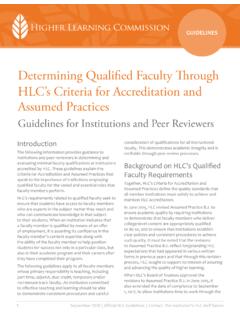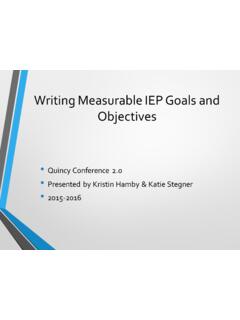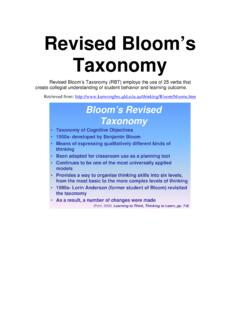Transcription of SETTING TARGETS IN STUDENT LEARNING OBJECTIVES
1 1 SETTING TARGETS IN STUDENT LEARNING OBJECTIVES USER GUIDE This document includes guidance about how to set TARGETS during the STUDENT LEARNING Objetive (SLO) process. The pages that follow define terms, delineate different types of TARGETS , and provide insight to help guide educators decision making. It is intended to support teachers, administrators, and district leaders as they continue to strengthen the SLO process in their varied contexts. WHAT S INSIDE Introduction .. 2 A Conceptual Understanding of Target- SETTING as Part of the SLO Process .. 3 What is a target and why is SETTING one an essential part of the SLO process? .. 3 How do you determine TARGETS that are rigorous yet attainable? .. 4 What does mastery or proficiency of the relevant course or grade-level standards and curriculum look like?
2 4 What amount of progress toward mastery or proficiency represents a year s worth of LEARNING ? .. 5 What are the implications if students make a year s worth of LEARNING ? .. 5 The Process of Determining TARGETS for STUDENT LEARNING OBJECTIVES .. 7 Frequently Asked Questions about Target SETTING .. 9 How do I know what the standard for proficiency should be for a local assessment? .. 9 How can there be comparability between local assessments? .. 9 Why isn t assigning TARGETS the solution to comparable rigor? .. 10 How can I tier TARGETS so that they are rigorous but attainable for all students? .. 10 Should I express TARGETS in terms of progress or achievement? .. 13 How can I write TARGETS if I include multiple measures? .. 15 Resources to Support the Target SETTING Process.
3 19 2 Standards & Curriculum Assessment Instruction INTRODUCTION As a goal- SETTING process, SLOs incorporate the core elements of teaching: they are based on standards & curriculum, their use and results help inform instruction, and they are monitored and measured using assessment. At the intersection of these core elements is strategic data use and SLOs. Through a variety of assessment techniques, teachers constantly use qualitative and quantitative data to monitor STUDENT LEARNING and guage the effectiveness of short and long-term standards-based instruction. The process of SETTING goals and monitoring progress toward those goals is simply part of strong instructional practice, and participating in goal- SETTING processes increases the impact an educator has on STUDENT LEARNING .
4 In Rhode Island, educators create SLOs based on long-term LEARNING goals for students. When writing an SLO, teachers ask themselves the following three Essential Questions: 1. What are the most important knowledge/skills I want my students to attain by the end of the interval of instruction? 2. Where are my students now (at the beginning of instruction) with respect to the objective? 3. Based on what I know about my students, where do I expect them to be by the end of the interval of instruction and how will they demonstrate their knowledge/skills? Once educators have answered the first two essential questions by identifying the Priority of Content and examining baseline data and information they are ready to answer the third essential question and think about where students should be at the end of the interval of instruction ( TARGETS ) and how they will demonstrate their skills/knowledge (evidence sources).
5 SLOs 3 A B A CONCEPTUAL UNDERSTANDING OF TARGET- SETTING AS PART OF THE SLO PROCESS WHAT I S A T ARG ET AND WHY I S SET T I N G ON E AN ESSEN T IAL PART OF T HE SLO PROC ES S? The third essential question prompts educators to articulate the level of content knowledge or skills that are critical for students to develop while in the educator s class; this is the target(s). Writing a target involves defining the level of content knowledge and skills that students will have at the end of the interval of instruction. A target is not simply a test score. A target may be expressed as a score on an assessment but that score must represent a level of performance that reflects students performance on critical content knowledge and skills.
6 Only after you define the knowledge and skills that students will develop can you find or create the right evidence source to allow students to demonstrate these knowledge and skills, along with defining cut scores, if necessary. Furthermore, There must be a target for each STUDENT in the class represented by the SLO; The target should be measurable; and The target should be rigorous yet attainable for the interval of instruction; in most cases, the target should be tiered to reflect students differing baselines. At its most basic, target SETTING for SLOs occurs when educators describe where students are, in regards to the prioritized content knowledge or skills, at the beginning of the interval of instruction (Point A) and then name a goal for where students will be in regards to that knowledge and skills at the end of the interval of instruction (Point B).
7 One Rhode Island school leader described the SLO process and the act of SETTING TARGETS as follows: An SLO is nothing more than a roadmap. We have a destination but there are pits and stops along the way where you pull over and use the map to reflect and to redirect where necessary so that you can get to that destination. In order to set rigorous but realistic TARGETS , you need at least a basic idea of where students are starting; that is baseline data. Tool #2 in the Assessment Toolkit, along with the accompanying online module, discusses baseline data and information and how it can help with the target- SETTING process. For a link to the resources, please see page 15. It is important to note that the elements included (knowledge/skills, baseline data/information, TARGETS and assessments) in the three essential questions are It is important to note that the three elements included in the three essential questions are interconnected.
8 A target is not simply a test score. 4 interconnected; TARGETS are connected to STUDENT baseline data/information and also to the assessment an educator is using, all of which is related to the content and skills of the objective statement. HOW DO YOU DET ERMI N E T ARG ET S T HAT ARE RI GOROUS YET AT T AI NAB LE? While SETTING TARGETS , educators and evaluators are encouraged to consider what is rigorous yet attainable for students. But, educators often ask, How do you determine what is rigorous and attainable? SETTING TARGETS that are too rigorous so that they are unrealistic hurts students and teachers alike. Conversely, SETTING TARGETS that are not adequately rigorous can hurt students by lowering the expectations adults have for them and decreasing necessary urgency for significant progress.
9 Finding a middle ground by trying to answer this question directly is rarely fruitful. Alternatively, educators and evaluators should use the following three questions to guide them as they write, review, and approve SLO TARGETS for students in the educator s class or course: 1. What does mastery or proficiency of the relevant course or grade-level standards or curriculum look like? 2. What amount of progress toward that mastery or proficiency represents a year s worth of LEARNING ? 3. What are the implications if students make a year s worth of LEARNING ? Answering the three questions above can be challenging, but it s a vital task for educators to engage in. Ultimately, it will help educators and districts as they simultaneously write SLOs, develop their comprehensive assessment systems, and work toward larger educational goals.
10 As educators answer these questions they can utilize data from prior SLOs to better evaluate the breadth and depth of content, rigor of target, and STUDENT readiness for the next level of instruction. For additional guidance on answering the three core questions that educators and evaluators should use to help them write, review, and approve SLO TARGETS , see below: 1. WHAT DOES MAST E RY OR PROFI C I EN C Y OF T HE RELEVAN T C OURSE OR G RADE-LEVEL ST AN DARDS AN D C URRI C ULUM LOOK LI KE? Once the content focus of an SLO has been set, the teacher should think about or, if possible, discuss with colleagues what it would look like for students to demonstrate that LEARNING . What would students know and be able to do by the end of the interval of instruction? How can students demonstrate what they know and are able to do?

